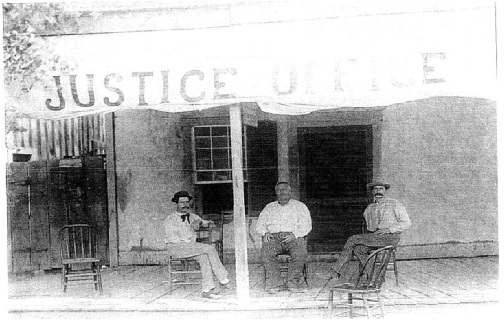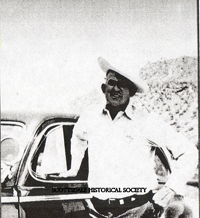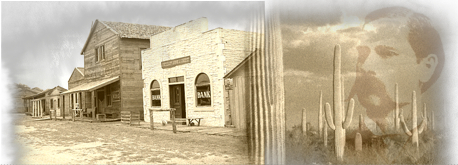ABOUT CONSTABLES
Constables have served Arizona since the inception of the territory in 1863. Constables are the elected peace officers of the justice precinct, and have the same powers, duties and liabilities as sheriffs, as far as applicable. Constables are elected to 4-year terms in their precinct, and serve all papers, processes, writs and warrants from their justice courts and any competent authority.Constables conduct asset seizures to fulfill court judgments, conduct evictions, serve protective orders, summonses, subpoenas, and both civil and criminal arrest warrants. Constables who are elected by voters within their judicial precincts are able to provide timely and cost efficient service by working directly with the courts in their local communities to ensure the court's orders are served.
The Arizona Constables Association serves its members by offering professional training to enable them to perform their duties. The Association holds a minimum of two training seminars per year at which time training and updates are provided that comply with requirements mandated by state law.
ARIZONA CONSTABLES IN HISTORY
Welcome to our history of Arizona constable. We have prepared historical information about some of the first constables in Arizona. The history of the constable was compiled by Ryan Reinhold, Navajo County Constable of Precinct Six, and Ron Williams, Yavapai County Constable for Prescott Precinct. Much more historical information about Arizona Constables can be found on our Facebook page.Back to Top
CONSTABLE ENRIQUE "HENRY" GÁRFIAS

Constable Enrique "Henry" Gáias on the left, Constable Hiram McDonald center, c. 1880, Phoenix Police Museum
Enrique "Henry" Gárfias was an early Phoenix community leader, and the first Hispanic to hold an elected office in the city. Gárfias was born in Mexico, and grew up in California. He came to Phoenix in 1874. Four years later he ran for town constable and won, defeating several Anglo candidates. His duties included serving legal notices and assisting in operations of the peace court. In 1881, Gárfias ran for the position of Phoenix's first city marshal. Once elected, his duties included assessor, tax collector, road commissioner, dog catcher, and zanjero, in addition to law enforcement. He held this office until 1886, and was popular with Anglo and Mexican residents. He developed a reputation as a tough lawman who always caught the criminals. He married Elena Redondo in 1883, originally of Yuma. They had two children, and she died in childbirth after the third. Gárfias remarried in 1891.He also owned cattle at Castle Hot Springs, served as the editor of the El Progreso del Valle newspaper (owned by José Luis Redondo, his father-in-law), and provided services as a language interpreter. In 1892, the Phoenix city directory lists him as living at Papago (3rd Avenue) and Jefferson Streets. Gárfias died in 1896. The Phoenix Herald memorialized him, remarking that he "gave the greatest satisfaction to the citizens of Phoenix. He was brave and conscientious and never failed in his duty no matter how danger menaced him."(see original for full citation listing)
This article and image is from the City of Phoenix's Hispanic Historic Property Survey which can be found under Establishing a Community or directly from the pdf.
Back to Top
CONSTABLE AL FREDERICK
 Al Frederick became Constable of the unincorporated town of Scottsdale circa 1920, and served in the post until his death in May 1950. For three decades, Frederick was the only lawman in Scottsdale, and helped many Scottsdale youth see the value in a law-abiding lifestyle. After his death, his wife, Ivy Donn Frederick, became Constable, at the time one of only two female law enforcement officers in the state of Arizona.
(2012, http://azmemory.azlibrary.gov/u?/splrem,9)
Al Frederick became Constable of the unincorporated town of Scottsdale circa 1920, and served in the post until his death in May 1950. For three decades, Frederick was the only lawman in Scottsdale, and helped many Scottsdale youth see the value in a law-abiding lifestyle. After his death, his wife, Ivy Donn Frederick, became Constable, at the time one of only two female law enforcement officers in the state of Arizona.
(2012, http://azmemory.azlibrary.gov/u?/splrem,9)
Back to Top
ARIZONA GOVERNOR WAS FIRST A CONSTABLE
In 1938, Wes Bolin was elected constable of the West Phoenix Precinct. He then served as Justice of the Peace in that precinct from 1942 to 1948, when he entered the Democratic primary race for Secretary of State. With his record-breaking longevity -- almost 30 years -- as secretary of state, Bolin earned a national reputation as a political leader. He was appointed Governor of Arizona in October 1977; he died of a heart attack while in office. Source: Goff, John F. Arizona Biographical Dictionary. Black Mountain Press. Cave Creek, Arizona 1983.Back to Top
BUCKET OF BLOOD AND A HANGING IN NAVAJO COUNTY
In 1885, the Board of Supervisors appointed Frank J. Wattron as the constable of Holbrook. The next year he was elected Navajo County Sheriff. To fill the vacancy, the Board of Supervisors appointed three constables for the precinct of Holbrook to take Wattron's place presumably because of the frequent gunfights on the dusty streets. The infamous Bucket of Blood saloon was next door to Wattron's own drugstore and bar. While serving as Sheriff, Wattron gained notoriety for sending this invitation to local officials: "You are hereby cordially invited to attend the hanging of one: George Smiley, Murderer. His soul will be swung into eternity on Dec. 8, 1899, at 2 o'clock p.m. sharp. The latest improved methods in the art of scientific strangulation will be employed and everything possible will be done to make the surroundings cheerful and the execution a success." Source: Navajo County Historical Society.Back to Top
CONSTABLE SHOOTS PRESCOTT CHIEF OF POLICE
On the evening of January 6, 1894, Prescott Constable Louis C. Miller shot Prescott Police Chief Miles Archibald. Seems the constable had arrested a suspect on a warrant but the Police Chief took exception and during an argument that ensued both lawmen drew arms on each other. Chief Archibald was shot twice in the shoulders. Constable Miller was exonerated in court.Back to Top
CONSTABLE ARRESTS COP KILLERS
In 1922, Constable R. L. McDonald climbed up the side of Tempe Butte, armed with a Winchester rifle, and arrested Bill and Babe Lawrence who had fled there after the murder of a deputy sheriff and a highway patrolman. Bill was later sentenced to death by hanging. McDonald received a $2500 reward, a princely sum in those days. Source: Arizona Republican newspaper-1924.Back to Top
TUCSON'S FIRST CONSTABLE
On May 8, 1864, Tucson residents appointed Jose Veremende constable and Charles Meyer, the local druggist, as justice of the peace. The two instituted a chain gang, which proved to be of enormous benefit toward maintaining the cleanliness and good repair of the town. A police department was founded in 1871; at the time, the corporate limits of Tucson were one square mile in size and the population was 3,200 people. Later that year, the first town marshal was appointed at a salary of $20 per month.Back to Top
YUMA COUNTY CONSTABLE
Henry Harrison "Harry" McPhaul moved to Yuma around 1897 and became constable. He also served as a guard at the Yuma Territorial Prison; a deputy sheriff and Yuma town marshal. He was the only Yuma resident who ever became an Arizona Ranger. He spent many years prospecting for gold and silver on his land near the Dome Bridge on the Gila River near Yuma. The bridge was eventually officially renamed McPhaul Bridge in his honor; it was the longest suspension bridge in Arizona at 798 feet and remained in service until 1968. Source: Yuma Sun newspaperBack to Top
WICKENBURG CONSTABLE WORLD CHAMPION
Everett Bowman, Constable in Wickenburg was its first and most famous cowboy winning 6 world rodeo championships in 1937. A multi-dimensional person, he was known throughout the west as the mule trainer, a pilot, a rancher, a member of the Arizona Highway Patrol, and Maricopa County Deputy Sheriff.Back to Top
COCONINO COUNTY CONSTABLE
Hubert "Bert" Lauzon served as a constable for Coconino County from 1922 to 1928. He kept a home on the south rim of the Grand Canyon where he was employed as caretaker of the Bright Angel Trail and Constable. He became a National Park Service Ranger in 1928.Back to Top
CONSTABLE'S HOME IS HISTORIC SITE
About 1915, Chester Cummins served several terms as Constable of the Tempe precinct. During one of Governor Hunt's administrations, Cummins was captain of the guards at the Arizona State Prison. He was also the Tempe Town Marshal. He lived at 839 S. Farmer Avenue in a board-and-batten house built in 1903 which is still standing today. Source: Tempe Historical MuseumBack to Top
CONSTABLE VIRGIL EARP OF PRESCOTT
In November of 1878, Virgil Earp was elected to the office of constable in Prescott. He was well respected in the community, having taken part in a shootout against Texas cowboys the previous year, where he partnered with the Sheriff, previous Constable, and United States Marshal. Constable Earp also won a firearms competition in Prescott, making 44 of 45 shots. Constable Earp would leave Prescott to be a deputy Unite States Marshal in Tombstone, and later the City Marshal of Tombstone. Later in life, Virgil would go on to be a constable then the town marshal in Colton, California.Back to Top
CONSTABLE RYE MILES
Zachariah Jeptha Taylor "Rye" Miles was born in 1865, in Texas. He served in the Spanish-American War, and as an Arizona Ranger. Rye Miles also served as the constable of the Benson Precinct, constable of the Casa Grande Precinct, and sheriff of Pima County.Back to Top
CONSTABLE FRED DODGE
Fred Dodge was an undercover Wells Fargo detective in Tombstone in 1879. Fred Dodge was a friend and ally to the Earps during their time in Tombstone. In 1884, Dodge was elected Constable of Tombstone, while still working under cover for Wells Fargo. While constable, he solved a number stage robberies.Back to Top
CONSTABLE DATE GRAHAM
Daton 'Date' Graham was the Constable of Douglas Precinct, Cochise County, for three terms, from 1898 until 1904. Prior to that, he was the Bisbee Constable from 1896 to 1898, and Cochise County Deputy Sherriff in Bisbee in 1895. A brave officer of the law, Graham is best remembered for his shootout in Douglas, in 1903, with himself and his Deputy Thomas Vaughn, against outlaw Ephraim 'Dave' Smith. Smith killed Deputy Vaughn and injured Constable Graham. Smith fled, but later returned to Douglas, where Constable Graham killed him.Back to Top
CONSTABLE JIM ROBERTS
Between 1893 and 1934, Jim Roberts served variously as deputy sheriff, constable and city marshal of Jerome. An incredibly brave lawman, he had at least seven documented shootouts with criminals. He was also known for chaining prisoners to a wagon wheel, after the Jerome jail burned down.Back to Top
CONSTABLE HAZE BURCH
Haze Burch served as Phoenix’s East Precinct constable from 1917 to 1922, and was prolific in arresting murders, fraudsters, auto thieves, bootleggers, armed gunmen and kidnappers. He ran for Maricopa County Sheriff in 1922, but lost. Haze Burch joined the Phoenix Police Department in 1922, and became their first line-of-duty death in 1925.Back to Top
CONSTABLES CONDUCT STING
In 1891, three constables arrested a Tucson businessman for illegally selling tobacco. Don Yan was convicted in justice court of 18 counts of violating an ordinance that prohibited the sale of cigarettes to minors under sixteen (16) years of age. Source: Territory of Arizona v. Don YanBack to Top
CHANDLER CONSTABLE
In November of 1914, about two years after statehood, Charles M. Beckham, was elected one of area's first Constables. The Town Marshal and the County Constable enforced laws in Chandler, along with surrounding areas of his district, including Gilbert. Early on, Beckham solved a burglary at the N.L. Nowell store in Gilbert, where the safe was blown up. Constable Beckham had an honorable career for about ten years but in 1924, he was convicted of aiding and abetting escapees from the Florence State Prison. Source: "Chandler Arizonan" newspaperBack to Top
SCOTTSDALE'S FIRST CONSTABLE
Maricopa County created a Scottsdale voting precinct and justice court in 1922. Constable Al Frederick and Justice of the Peace William Kimsey became influential leaders. At that time, a cotton gin had opened on Second Street and Brown Avenue to process Scottsdale-grown Pima cotton, which was in great demand during World War I. Source: The Arizona RepublicFirst Phoenix Constable: Rafael Estrada Sr., the city's first constable.
Tempe's First Constable: Tempe residents selected J. Andrade in 1872 as the town's first constable.
Back to Top
CONSTABLES IN 1800'S
The kind of police Americans knew in the early nineteenth century were descended from the medieval police of England -- a constable who patrolled the city and charged fees for his services. The constable system prevailed until cities grew larger and permanent police were hired. Until 1853, New York relied entirely on constables; Boston until 1859, and Philadelphia 1856 (Pennsylvania still elects state constables). Constables are active today in many states including: Texas, Tennessee, Arizona, Alabama, Pennsylvania, Utah, Nevada, Oregon, Louisiana, Mississippi, Georgia, Vermont, and New York. Source: Samuel Walker, Popular Justice: A History of American Criminal JusticeBack to Top
CONSTABLES KILLED
IN THE LINE OF DUTY

Deputy Constable James Hines
Pima County Constable
August 26, 1879
Pima County Constable
August 26, 1879
Constable Issac L. Roberts
Tombstone Justice Precinct/Cochise County
March 6, 1884
Tombstone Justice Precinct/Cochise County
March 6, 1884
Constable Chester Ainsworth
Pierce Justice Precinct/Cochise County
April 7, 1899
Pierce Justice Precinct/Cochise County
April 7, 1899
Constable William Lowther
Bisbee Justice Precinct/Cochise County
April 10, 1890
Bisbee Justice Precinct/Cochise County
April 10, 1890
Constable James Hawkins
Jerome Justice Precinct/Yavapai County
April 19, 1891
Jerome Justice Precinct/Yavapai County
April 19, 1891
Deputy Constable Thomas Vaughn
Douglas Justice Precinct/Cochise County
May 16, 1903
Douglas Justice Precinct/Cochise County
May 16, 1903
Constable Frank Trask
Benson Justice Precinct/Cochise County
May 9, 1911
Benson Justice Precinct/Cochise County
May 9, 1911
Constable Vic Melleck
Williams Precinct/Coconino County
June 7, 1919
Williams Precinct/Coconino County
June 7, 1919
Constable Andrew ‘Shep’ Sheppard
Bisbee Justice Precinct/Cochise County
September 16, 1920
Bisbee Justice Precinct/Cochise County
September 16, 1920
Constable Deborah Martinez
Justice Precinct 8/Pima County
August 25, 2022
Justice Precinct 8/Pima County
August 25, 2022
Back to Top

